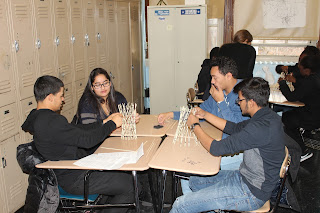First George explained some of the basic geometry of hyperboloids. One interesting thing in particular is that, while the surface of the hyperboloid is what we would normally call "curved," each point on the surface is the intersection of two straight lines.
Students began work.
Once they reached 12 pairs, they brought the ends around to join in a cylinder.
At this point, each pair of skewers is joined by one rubber band in the middle, and each interior skewer is joined to a neighbor exterior skewer by rubber bands at the top and bottom ends. To make room for more joins, the "end" rubber bands are slid in towards the middle. We'll then pair the ends to the new next neighboring skewer with a rubber band
This process is repeated until there are seven or more rubber bands holding each skewer to seven (or more) neighbors.
The constructed hyperboloid can be spread, or collapsed into a bundle of sticks.
Combinations are possible.
A good time was had by all (for the cost of a pack of skewers and a pack of rubber bands)
















No comments:
Post a Comment